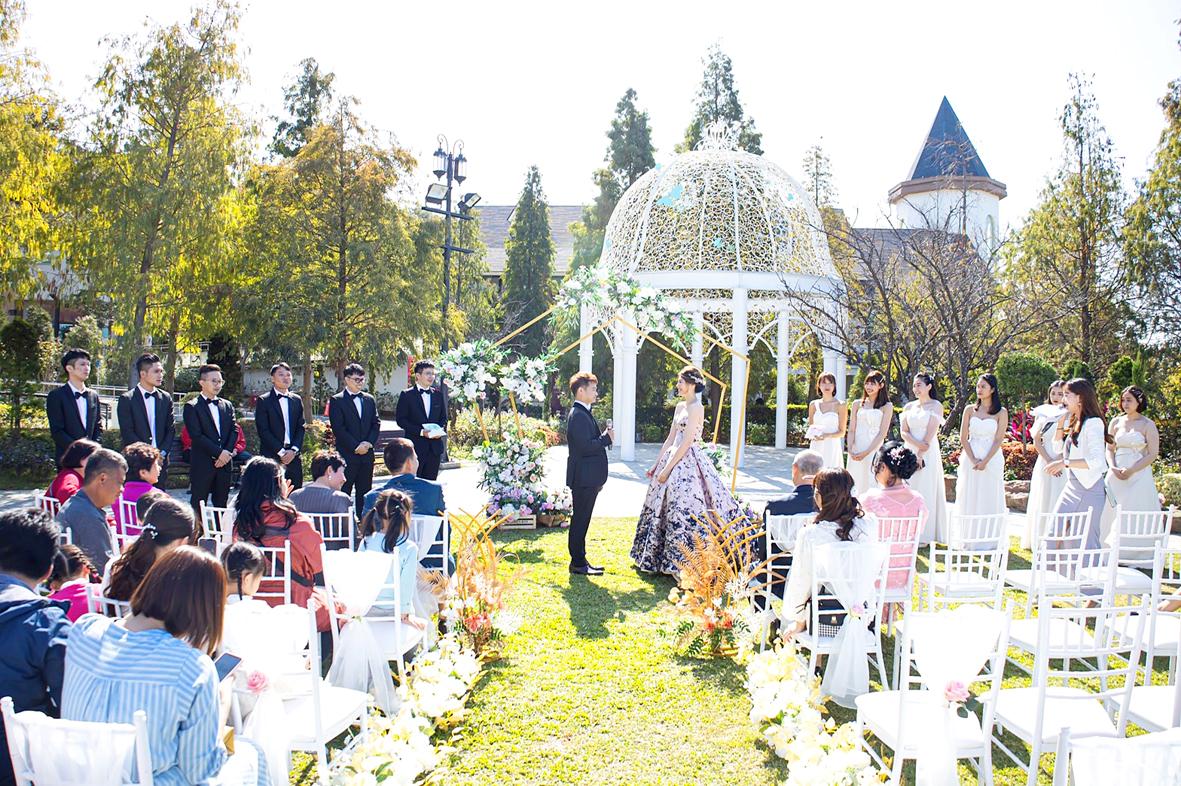I’d like to marry my girlfriend, a Filipino migrant worker, and have her move in with me as my wife. In most countries this would be a matter of paperwork. In Taiwan it’s not possible.
A few weeks ago I set off for the immigration office in Taichung’s Fongyuan District (豐原) to ask how to switch my girlfriend’s foreign laborer visa to a relative visa after we got married.
We can easily marry in Taiwan — in that respect Taiwan is the sanest place I have ever been. We just have to show up at the local household registration office with proof from our home nations that we’re not presently married, and the whole process can be done in minutes. It is the same for divorce, if both parties agree.

Photo courtesy of New Palace
The issue is getting her visa changed. I have a great job in Taichung that I really love, and I do not want to move to Hsinchu’s Jhubei City (竹北), where she works in a factory, to live with a woman who comes home at 8:40pm five nights a week, exhausted after a brutal 14 hour day.
My first stop, the immigration office in Fongyuan, laid it all out for me very clearly. The very nice immigration officer explained that if they cannot do it in-country: “She has to leave the country and go through a process at the Taiwan Representative Office in Manila. Then she can come back in on a relative visa.”
At that point I stopped him.
“You do know that the Ministry of Foreign Affairs (MOFA) is not granting any new residency visas, right? So if she leaves the country she can’t come back in.”
He did his deer-in-the-headlights imitation. “What? Really?” Then he shouted back to his supervisor to ask if this was true. She hadn’t known and came over to confirm this wondrous new fact with me.
Imagine what might have happened if I hadn’t known that fact.
Last week I continued my quest with a quick strike at the MOFA office in central Taichung. There the low-level worker at the window gave me the same information. After he told me she would have to leave the country, I cut in, “But then she can’t come back, right? MOFA isn’t giving out new residency visas.”
He laughed sheepishly. “Oh yeah, that’s right.” I pressed the issue, and they brought in the supervisor.
We had a long talk. It wasn’t a MOFA issue, she explained. No, we do not do it here. See if you can switch it at the National Immigration Agency (NIA), she suggested. I told her I’d already been there. She asked which one, and then told me that those guys in Fongyuan are sometimes a bit uninformed.
“Go ask the main office just off Wenxin Road. If they will accept it, it can be done.”
But she warned me that because my girlfriend was a Southeast Asian, it might be less possible, a comment I had heard her make when she was chatting about my situation with her coworkers.
This was a bit confusing to me, since I know that MOFA and not the NIA gives visas, but I headed over there anyway, only to be told that MOFA does in fact issue visas. The very nice lady there commiserated with me. “You will just have to wait until things get back to normal.”
It has now been 18 long months since Taiwan shut its borders due to COVID-19. In all that long span of time MOFA has not established an alternative that allows people already here to switch to new visas inside Taiwan. It has simply shrugged its shoulders and blamed COVID, as if the situation were the result of natural law, not amenable to human action.
I am hardly the only person in some variant of this situation. An acquaintance of mine is a North American who wants to marry a woman from Thailand, here as a student. Same problem — she has to return to Thailand in order to switch her visa, and won’t be able to re-enter.
After over a year of complaints, last month the government grudgingly permitted spouses and children of Republic of China (ROC) nationals to enter Taiwan for humanitarian reasons, under the rubric of “joining family.”
This refusal to create an alternative visa mechanism is not a COVID issue. This is a problem of deep bureaucratic indifference, incompetence and racism. The government knows perfectly well that if foreign workers can marry and switch their visas to relative visas in Taiwan, some will leave their factory work.
Because few new workers are entering Taiwan, migrant workers are in high demand, especially with the export side of the economy booming (in your daily experience the economy may be stagnant, but government spreadsheets show that economic growth this year has been the fastest in a decade).
Hence, this lack of a simple mechanism for switching visas in Taiwan functions to keep migrant workers in their job. Bureaucrats can simply shrug, as the immigration official did, and declare they are too low on the totem pole to change things. The high cost of quarantine also helps reduce the ability of individuals from less developed nations to travel in and out as well.
The assumption that at some point things will return to normal is highly problematic. COVID-19 isn’t going to go away any time soon. Given the anti-vax stances of so many individuals, it is likely that reservoirs of unvaccinated people will exist in many nations, churning out new variants and new breakthrough clusters.
Some nations, especially those run by incompetent autocrats or experiencing political turmoil, will be unable to bring the disease under control. COVID-19 is not going to be like AIDS, the disease of a few unlucky people, but more like tuberculosis in the 19th century, a constant malevolent presence in our lives.
It is time for MOFA to wake up and smell the Kafka. People seeking to be married are but one subset of the people who need the ability to smoothly switch their visas in-country. MOFA needs to set up a facility to do this, and pronto. A country that is suffering a population decline should be making it easier, not impossible, for people to marry and have children.
The current lack of this facility is just one part of a severe problem across Taiwan and its interface with the outside world — while Taiwan frequently represents itself as a place where it is easy to do business, or open a business, carry out banking, etc, foreigners who attempt to do these things report the opposite.
For a nation whose continued existence depends on robust, diverse connections with the world outside, this discontinuity between what is seen in the mirror and what is experienced by outsiders could well be fatal.
Notes from Central Taiwan is a column written by long-term resident Michael Turton, who provides incisive commentary informed by three decades of living in and writing about his adoptive country. The views expressed here are his own.

The Taipei Times last week reported that the rising share of seniors in the population is reshaping the nation’s housing markets. According to data from the Ministry of the Interior, about 850,000 residences were occupied by elderly people in the first quarter, including 655,000 that housed only one resident. H&B Realty chief researcher Jessica Hsu (徐佳馨), quoted in the article, said that there is rising demand for elderly-friendly housing, including units with elevators, barrier-free layouts and proximity to healthcare services. Hsu and others cited in the article highlighted the changing family residential dynamics, as children no longer live with parents,

It is jarring how differently Taiwan’s politics is portrayed in the international press compared to the local Chinese-language press. Viewed from abroad, Taiwan is seen as a geopolitical hotspot, or “The Most Dangerous Place on Earth,” as the Economist once blazoned across their cover. Meanwhile, tasked with facing down those existential threats, Taiwan’s leaders are dying their hair pink. These include former president Tsai Ing-wen (蔡英文), Vice President Hsiao Bi-khim (蕭美琴) and Kaohsiung Mayor Chen Chi-mai (陳其邁), among others. They are demonstrating what big fans they are of South Korean K-pop sensations Blackpink ahead of their concerts this weekend in Kaohsiung.

Taiwan is one of the world’s greatest per-capita consumers of seafood. Whereas the average human is thought to eat around 20kg of seafood per year, each Taiwanese gets through 27kg to 35kg of ocean delicacies annually, depending on which source you find most credible. Given the ubiquity of dishes like oyster omelet (蚵仔煎) and milkfish soup (虱目魚湯), the higher estimate may well be correct. By global standards, let alone local consumption patterns, I’m not much of a seafood fan. It’s not just a matter of taste, although that’s part of it. What I’ve read about the environmental impact of the

Oct 20 to Oct 26 After a day of fighting, the Japanese Army’s Second Division was resting when a curious delegation of two Scotsmen and 19 Taiwanese approached their camp. It was Oct. 20, 1895, and the troops had reached Taiye Village (太爺庄) in today’s Hunei District (湖內), Kaohsiung, just 10km away from their final target of Tainan. Led by Presbyterian missionaries Thomas Barclay and Duncan Ferguson, the group informed the Japanese that resistance leader Liu Yung-fu (劉永福) had fled to China the previous night, leaving his Black Flag Army fighters behind and the city in chaos. On behalf of the